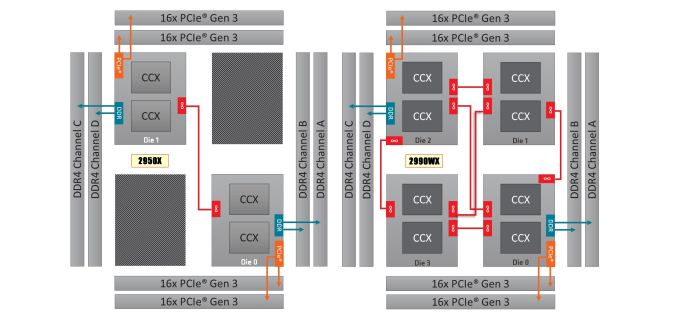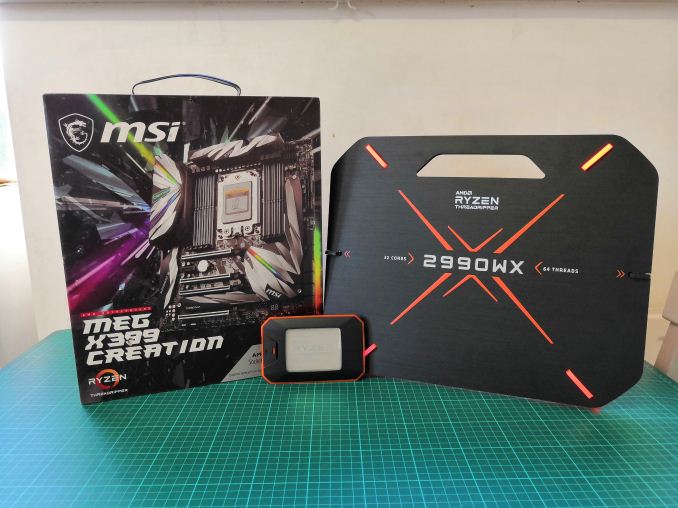The AMD Threadripper 2990WX 32-Core and 2950X 16-Core Review
by Dr. Ian Cutress on August 13, 2018 9:00 AM ESTConclusions: Not All Cores Are Made Equal
Designing a processor is often a finely tuned craft. To get performance, the architect needs to balance compute with throughput and at all times have sufficient data in place to feed the beast. If the beast is left idle, it sits there and consumes power, while not doing any work. Getting the right combination of resources is a complex task, and the reason why top CPU companies hire thousands of engineers to get it to work right. As long as the top of the design is in place, the rest should follow.
Sometimes, more esoteric products fall out of the stack. The new generation of AMD Ryzen Threadripper processors are just that – a little esoteric. The direct replacements for the previous generation units, replacing like for like but with better latency and more frequency, are a known component at this point and we get the expected uplift. It is just this extra enabled silicon in the 2990WX, without direct access to memory, is throwing a spanner in the works.
2950X (left) and 2990WX (right)
When some cores are directly connected to memory, such as the 2950X, all of the cores are considered equal enough that distributing a workload is a fairly easy task. With the new processors, we have the situation on the right, where only some cores are directly attached to memory, and others are not. In order to go from one of these cores to main memory, it requires an extra hop, which adds latency. When all the cores are requesting access, this causes congestion.
In order to take the full advantage of this setup, the workload has to be memory light. In workloads such as particle movement, ray-tracing, scene rendering, and decompression, having all 32-cores shine a light means that we set new records in these benchmarks.
In true Janus style, for other workloads that are historically scale with cores, such as physics, transcoding, and compression, the bi-modal core caused significant performance regression. Ultimately, there seems to be almost no middle ground here – either the workload scales well, or it sits towards the back of our high-end testing pack.
Part of the problem relates to how power is distributed with these big core designs. As shown on page four, the more chiplets that are in play, or the bigger the mesh, the more power gets diverted from the cores to the internal networking, such as the uncore or Infinity Fabric. Comparing the one IF link in the 2950X to the six links in 2990WX, we saw the IF consuming 60-73% of the chip power total at small workloads, and 25-40% at high levels.
In essence, at full load, a chip like the 2990WX is only using 60% of its power budget for CPU frequency. In our EPYC 7601, because of the additional memory links, the cores were only consuming 50% of the power budget at load. Rest assured, once AMD and Intel have finished fighting over cores, the next target on their list will be this interconnect.
But the knock on effect of not using all the power for the cores, as well as having a bi-modal operation of cores, is that some workloads will not scale: or in some cases regress.
The Big Cheese: AMD’s 32-Core Behemoth
There is no doubting that when the AMD Ryzen Threadripper 2990WX gets a change to work its legs, it will do so with gusto. We were able to overclock the system to 4.0 GHz on all cores by simply changing the BIOS settings, although AMD also supports features like Precision Boost Overdrive in Windows to get more out of the chip. That being said, the power consumption when using half of the cores at 4.0 GHz pushes up to 260W, leaving a full loaded CPU nudging 450-500W and spiking at over 600W. Users will need to make sure that their motherboard and power supply are up to the task.
This is the point where I mention if we would recommend AMD’s new launches. The 2950X slots right in to where the 1950X used to be, and at a lower price point, and we are very comfortable with that. However the 2950X already sits as a niche proposition for high performance – the 2990WX takes that ball and runs with it, making it a niche of a niche. To be honest, it doesn’t offer enough cases where performance excels as one would expect – it makes perfect sense for a narrow set of workloads where it toasts the competition. It even outperforms almost all the other processors in our compile test. However there is one processor that did beat it: the 2950X.
For most users, the 2950X is enough. For the select few, the 2990WX will be out of this world.












171 Comments
View All Comments
HStewart - Monday, August 13, 2018 - link
"I highly highly doubt that Intel would postpone 10nm just to “shut down AMD""Probably right - AMD is not that big of threat in the real world - just go in to BestBuy - yes they have some game machines. a very few laptops including older generations
Spunjji - Tuesday, August 14, 2018 - link
That is some impressive goalpost moving that you just did *on your own claim*.Intel's issues have nothing to do with AMD, but they will allow a resurgent AMD to become more competitive over time. Pointing to how little of a threat AMD are *right now* and/or making up weird conspiracy theories that place Intel as the only mover and shaker in the entire industry won't change that.
Relic74 - Wednesday, August 29, 2018 - link
Consumer based computers is but a small portion of the market. Servers, millions of them needed every year to fill the demand needed by, well, everyone who hosts a site, government, networking farms a mile long, etc. The server market is huge and is growing almost faster than tech companies can provide. It's why I always thought Apple getting out if the server market was kind of a stupid ideal. All of the servers they ever created were sold before they were even created. I guess the margains were to small for them, greedy bastards. Why only make double the profits when you make 5x with consumer products. Seriously, an iPhone X costs less than $200 to make now, it used to be $250 but now its $200, greedy bastards. Oh, did you know it costs Apple less than $3 to go from 64GB to 128GB, ugh.Ozymankos - Sunday, January 27, 2019 - link
it matters what you consider as costsdo you calculate the shipping costs,the marketing costs,the salaries of everyone involved,the making of new facilities?
Eastman - Tuesday, August 14, 2018 - link
Intel isn't finished. They are still king of single thread performance. We will see if Zen 2 will surpass Intel's single thread performance.seanlivingstone - Monday, August 13, 2018 - link
Do you know that Jensen Huang is Lisa Su's uncle? Intel is done.f1nalpr1m3 - Thursday, October 25, 2018 - link
Expected Results vs Actual:Stats Expected Q3 2018 Results Actual Q3 2018 Results
Revenue($B) $18.1 $19.2
EPS $1.15 $1.40
UnNameless - Tuesday, August 14, 2018 - link
Sadly this is true. AMD tries hard and in the most part succeeds. Intel frankly showed some kind of panic for the niche market of top end processors with that chilled fiasco of a 5 GHz CPU. This means AMD puts quite some pressure onto themOutlander_04 - Tuesday, August 14, 2018 - link
AMD have bounced back very quickly . Mostly because people are starting to accept how over priced intel have beenhttps://wccftech.com/intel-coffee-lake-amd-ryzen-c...
twtech - Wednesday, August 15, 2018 - link
I don't think branding issues is going to stop purchases of AMD chips when they are the best fit for a particular use-case, but the lack of direct access to memory for half of the cores in the 2990wx is going to keep it from being the knockout punch for HEDT that it could have been.Looking at these benchmark results, that has seriously gimped the performance of the 32-core TR to the point where it is slower than the 16 core in some threaded workloads.
Sure, you can just go ahead and buy the 16-core 2950x instead, but then you're reduced back to being in 7980xe territory - albeit at a cheaper price point - but the point is, it's not the clear win that a relatively high clocked 32-core CPU probably could have been without the memory access issue.